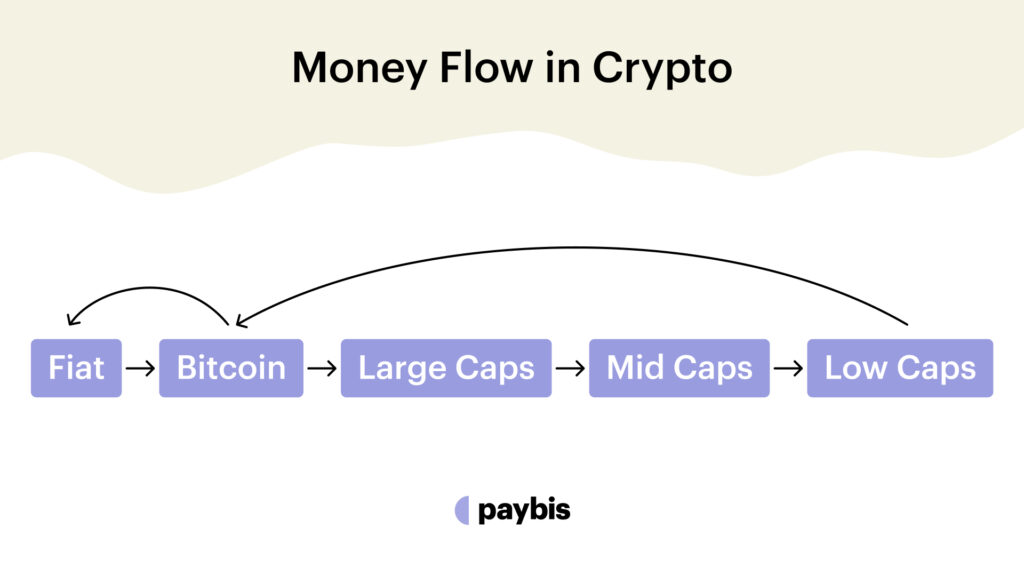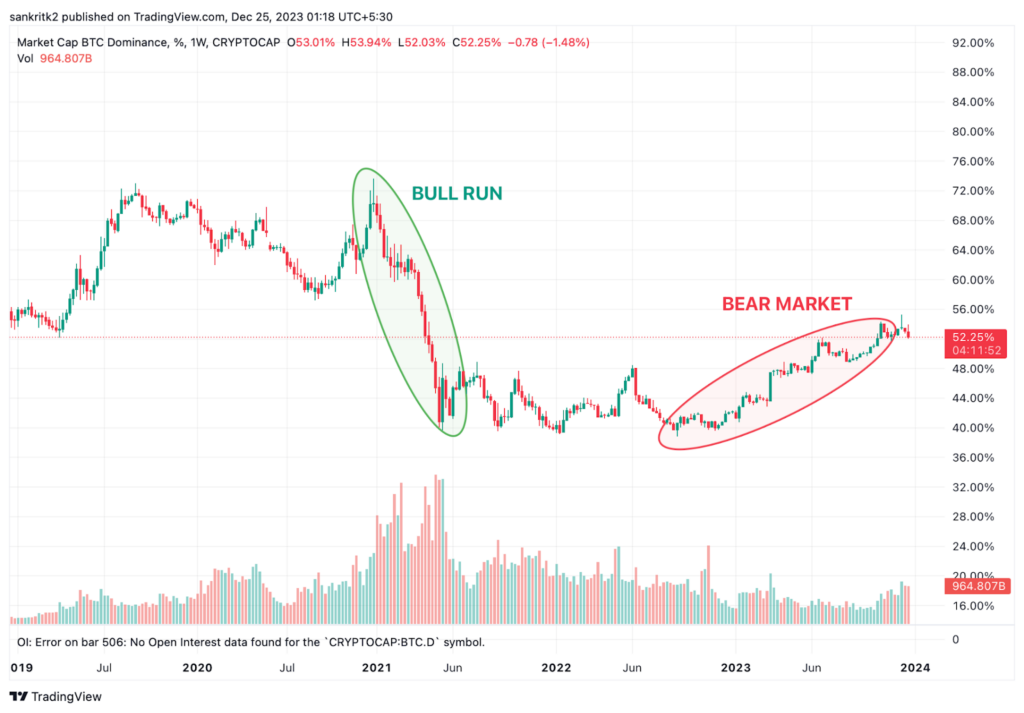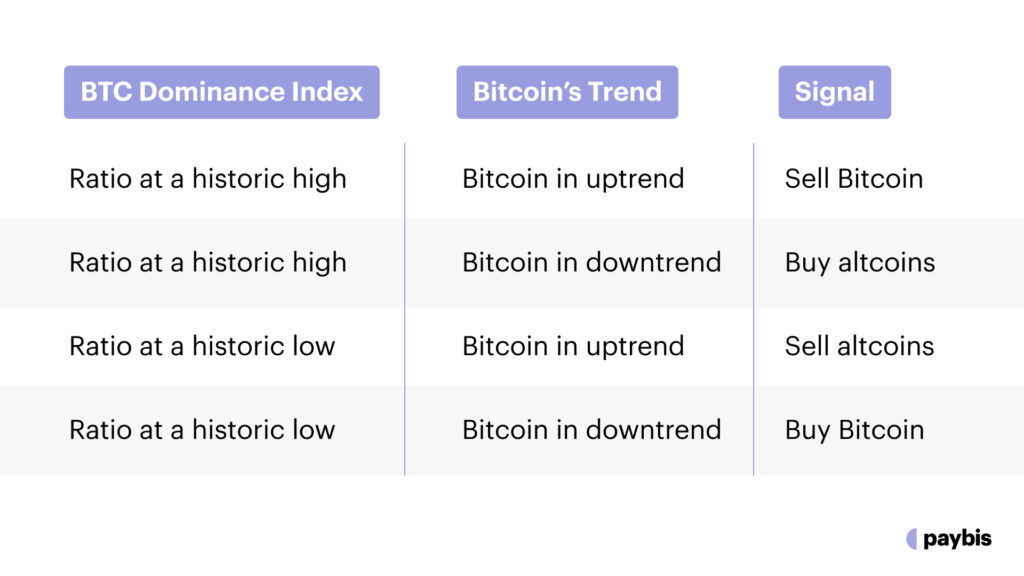Bitcoin Dominance
Bitcoin dominance is a metric that attempts to quantify BTC’s influence over the multi-trillion-dollar crypto landscape.
Did you know that Bitcoin wasn’t the first cryptocurrency? There were quite a few attempts to create a stronger financial value exchange system than the traditional one much before BTC became a thing.
Satoshi Nakamoto, however, changed the playground by introducing blockchain. This meant Bitcoin would be the first cryptocurrency that would be truly decentralized — a feat that its predecessors failed to achieve.
As a result, Bitcoin has not only challenged traditional notions of currency but also established a new paradigm in financial markets. Its influence extends beyond its valuation, casting a significant shadow over the entire cryptocurrency landscape.
Bitcoin dominance is a metric that attempts to quantify BTC’s influence over the multi-trillion-dollar crypto landscape.
In this article we will explore what is Bitcoin dominance, how it originated, how it is measured and how you can read the Bitcoin dominance chart to make informed decisions.
Table of contents
What is Bitcoin Dominance?

Bitcoin dominance refers to the measure of Bitcoin’s value in comparison to the total market capitalization of all other cryptocurrencies combined. It’s a commonly used metric in the cryptocurrency market to gauge Bitcoin’s market share relative to the entire crypto market.
Here’s how it works:
- Market Capitalization: This is the total value of a cryptocurrency, calculated by multiplying its current price by the total number of coins in circulation. For Bitcoin, this would be the price of one Bitcoin multiplied by the total number of Bitcoins in existence.
- Total Cryptocurrency Market Cap: This is the sum of the market capitalizations of all cryptocurrencies in the market, including Bitcoin.
- Bitcoin Dominance Percentage: This is calculated by dividing Bitcoin’s market capitalization by the total market cap of all cryptocurrencies and then multiplying by 100 to get a percentage.
Bitcoin Dominance=(Bitcoin Market Cap/Total Crypto Market Cap) x 100
Bitcoin dominance is an important metric because it indicates the level of investment and interest in Bitcoin compared to other cryptocurrencies. A high Bitcoin dominance percentage suggests that Bitcoin holds a significant portion of the market, indicating a preference or higher confidence among investors for Bitcoin over other cryptocurrencies. Conversely, a lower dominance can imply a growing interest and investment in alternative cryptocurrencies (altcoins).
This metric is closely watched by crypto investors and analysts as it can reflect shifts in the sentiment and trends within the cryptocurrency market.
Origin of Bitcoin Dominance: A Look into the Past
When Bitcoin was first mined into existence, it was the only player in the digital currency landscape, giving it an implicit 100% dominance by default. Over time, other cryptocurrencies, commonly referred to as altcoins (alternative coins), began to emerge. These included notable names like Litecoin, Ethereum, Ripple, and many others. Each new cryptocurrency aimed to improve upon or offer different features than Bitcoin.
With the growth in the number of cryptocurrencies, there arose a need for a metric to understand Bitcoin’s market position relative to the entire market. This need led to the conception of the Bitcoin dominance metric.
Market capitalization became the standard measure to gauge the size and dominance of a cryptocurrency. Bitcoin’s market cap was compared against the cumulative market cap of all other cryptocurrencies to determine its dominance.
Further, it soon became evident that Bitcoin did not just have the highest market cap, but is a longstanding beacon of crypto market longevity. Meaning that if Bitcoin went down, it could take the entire market with it. At the same time, if Bitcoin skyrocketed, the altcoins would follow suit due to rising investor confidence. This gave to the popular crypto money flow cycle chart.

The crypto money flow cycle is a concept used to describe the typical pattern of investment flow within the cryptocurrency market. It’s a theoretical model that tries to explain how money tends to move between different types of cryptocurrencies (like Bitcoin, large-cap altcoins, small-cap altcoins) over time, often in response to market cycles and investor sentiment. This cycle is not a strict or guaranteed pattern but rather a general trend observed by some investors and analysts.
Since the cycle often starts and ends with Bitcoin (disregarding the involvement of fiat currencies as they primarily just serve as a point of entry into the industry), the concept of Bitcoin dominance becomes even more crucial and a metric to monitor.
Understanding the Bitcoin Dominance Chart
Bitcoin dominance charts are a crucial tool for understanding the relative strength of Bitcoin in the cryptocurrency market. For beginners, these charts might seem daunting, but with a bit of guidance, they can be a valuable resource.
Reading and Interpreting BTC Dominance Chart
You’ll typically see a line graph with time on the horizontal axis (X-axis) and the percentage of Bitcoin dominance on the vertical axis (Y-axis). This chart is unique as it does not reflect prices but market share.
- Time (X-Axis): The time scale can greatly affect the chart’s interpretation. A shorter time frame, like days or weeks, can show quick fluctuations, highlighting short-term trends or reactions to specific events. In contrast, a longer time frame, like months or years, provides a broader view, showing long-term trends and shifts in investor sentiment.
- Percentage of Dominance (Y-Axis): This scale is the heart of the chart. The percentage indicates how much of the total cryptocurrency market capitalization is made up of Bitcoin. It’s crucial to understand that a small change in percentage can represent a significant shift in capital.

The direction of the line is your first big clue in spotting potential uptrends and downtrends of the crypto market. An uptrend in Bitcoin dominance could mean investors are favouring Bitcoin, possibly viewing it as a safe haven during market turbulence. A downtrend might suggest growing confidence in altcoins, indicating a willingness among investors to diversify and take on more risk.
The steepness and duration of a trend can tell you about the market’s momentum. A sharp increase in Bitcoin dominance might indicate a sudden shift in investor sentiment, possibly due to a major event. Conversely, a gradual trend could suggest a slow but steady change in long-term investor preferences.
BTC Dominance vs Other Technical Analysis Metrics
Bitcoin dominance differs from other technical analysis metrics primarily in its focus and method of calculation. It’s a market-wide metric rather than a price-specific metric, and this distinction sets it apart from most other tools in technical analysis. Let’s break down these differences.
Bitcoin dominance is concerned with Bitcoin’s market share relative to the entire cryptocurrency market. It doesn’t directly consider the price movements of Bitcoin or other individual cryptocurrencies.
In contrast, many technical analysis metrics, like moving averages, Relative Strength Index (RSI), or Bollinger Bands, focus specifically on the price action and volatility of a single asset over time.
Method of Calculation
Bitcoin dominance is calculated using market capitalization. The formula is:
Bitcoin Dominance=(Bitcoin Market Cap/Total Crypto Market Cap) x 100
Other technical analysis metrics are calculated based on different aspects of price and volume data. For example, moving averages are calculated using average prices over a specified period, and RSI is calculated based on recent price gains and losses.
Reflects Market Sentiment Rather Than Price Trends
Bitcoin dominance gives insight into the overall sentiment of the cryptocurrency market towards Bitcoin versus altcoins. A higher dominance suggests a preference for or greater trust in Bitcoin.
Other technical analysis tools are used to identify trends, momentum, potential reversals, and trading ranges in the price of a specific asset.
Lack of Technical Signals
Bitcoin dominance doesn’t provide traditional technical signals like overbought/oversold conditions, trend reversals, or support/resistance levels, which are typical outputs of other technical analysis tools.
Instead, BTC dominance offers a macro view of Bitcoin’s position in the market.
Useful links
- How To Pay With Bitcoin
- List of Companies That Accept Bitcoin
- Crypto Investment Strategies
- Is Crypto Dead?
- What is a Shitcoin
Tips on Trading Using BTC Dominance
Trading cryptocurrencies (both BTC and altcoins) using Bitcoin dominance as a signal or metric can be an effective strategy, especially for those who understand the broader market dynamics.

When Dominance is Rising
- Conservative Approach: Increase your portfolio’s allocation to Bitcoin. As dominance rises, Bitcoin is generally considered a safer bet compared to altcoins.
- Profit-Taking from Altcoins: Consider taking profits from altcoins if you have them in your portfolio, as they might lose value relative to Bitcoin.
When Dominance is Falling
- Opportunity in Altcoins: Shift a portion of your investment to altcoins. A decreasing dominance often indicates that altcoins might outperform Bitcoin in the short term.
- Selecting Altcoins: Choose altcoins based on solid fundamentals, recent developments, and growth potential. Be cautious with very new or speculative tokens.
If you’re a long-term investor, use BTC dominance trends to adjust your portfolio’s balance between Bitcoin and altcoins over time.
For short-term traders, BTC dominance can guide quick strategic shifts between Bitcoin and altcoins, capitalizing on market sentiment changes.
Where to Track BTC Dominance?
Bitcoin dominance can be tracked on various cryptocurrency market data platforms and financial websites that provide comprehensive information on the cryptocurrency market.
Here are five of the most popular sources where you can track Bitcoin dominance:
- Paybis: While not explicitly, Paybis price pages provide a real-time view of BTC price, its market cap, and circulating supply. You can use this data to understand BTC’s momentum in the broader crypto market.
- CoinMarketCap: This is one of the leading cryptocurrency market data providers. It offers a chart for Bitcoin dominance percentage among other key metrics for the crypto market.
- TradingView: This platform provides advanced charting tools for all kinds of financial markets, including cryptocurrencies. You can track Bitcoin dominance and use various indicators to analyze the data.
- CoinGecko: Similar to CoinMarketCap, CoinGecko provides a wide array of data on cryptocurrencies, including Bitcoin’s market cap dominance.
- CoinStats: Known for its portfolio tracking and management features, it also provides statistics and charts on Bitcoin’s market capitalization and dominance.
Closing Thoughts
The concept of Bitcoin dominance not only quantifies the weight of Bitcoin within the crypto market but also acts as a litmus test for the sector’s sentiment, indicating whether the winds favor the flagship currency or the broader ecosystem of altcoins.
Grasping the nuances of Bitcoin dominance is not just about understanding its market share but also about recognizing its role as a bellwether for the cryptocurrency market’s directional trends. It serves as a guide for investors looking to navigate the cyclical ebbs and flows of investor confidence between Bitcoin and its contenders.
Follow Paybis blog closely to learn about more such market indicators that can help you in your crypto journey.
FAQ
What happens when Bitcoin dominance rises?
When Bitcoin dominance rises, it generally means that Bitcoin is outperforming altcoins. Investors may be seeking the relative safety of Bitcoin compared to other cryptocurrencies.
What happens when Bitcoin dominance decreases?
A decrease in Bitcoin dominance suggests that altcoins are gaining market share relative to Bitcoin. This could mean that investors are more willing to take risks on lesser-known assets for potentially higher returns.
Is BTC dominance a reliable metric for trading?
BTC dominance can be a useful metric for traders as it reflects the market’s sentiment towards Bitcoin versus altcoins. However, it should not be the sole basis for trading decisions; it’s best used in conjunction with other analyses.
What is the correlation between Bitcoin dominance and altcoin season?
Bitcoin dominance and altcoin season typically have an inverse relationship. When Bitcoin dominance falls, it often signals the start of an altcoin season, where altcoins gain market share and possibly increase in value.
What factors can affect Bitcoin dominance?
Factors that can affect Bitcoin dominance include:
- Market sentiment and investor confidence
- Regulatory news or changes
- Technological advancements within the crypto space
- Bitcoin’s performance relative to key altcoins
- Broader economic factors influencing risk appetite
Why is Bitcoin dominance important?
Bitcoin dominance is important because it shows Bitcoin’s market share relative to the entire cryptocurrency market, providing insights into investor behavior and market trends.
How does Bitcoin dominance work?
Bitcoin dominance works by showing Bitcoin’s market cap as a percentage of the total market cap of all cryptocurrencies. It helps gauge whether the market is favoring Bitcoin over altcoins at any given time.
What is the current Bitcoin dominance?
The live BTC dominance data can be found using the tools mentioned in the article. Historically, Bitcoin dominance has been on a decline as more altcoins are emerging with unique propositions.
Disclaimer: Don’t invest unless you’re prepared to lose all the money you invest. This is a high‑risk investment and you should not expect to be protected if something goes wrong. Take 2 mins to learn more at: https://go.payb.is/FCA-Info


